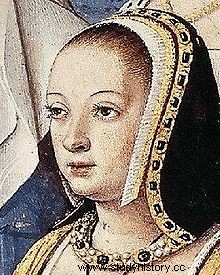Anne of Brittany (1477 – 1514) was Duchess of Brittany then Queen of France. In Brittany, it is a symbol of defense of the region.
Duchess of Brittany
 Anne de Bretagne was born in January 1477 in the castle of the Dukes of Brittany in Nantes. She is the daughter of Duke François II of Brittany and Marguerite de Foix. Raised by a governess, she received a noble education, learning to read and write and perhaps to dance and sing.
Anne de Bretagne was born in January 1477 in the castle of the Dukes of Brittany in Nantes. She is the daughter of Duke François II of Brittany and Marguerite de Foix. Raised by a governess, she received a noble education, learning to read and write and perhaps to dance and sing.
François II has no male heir, and decides to have his daughter recognized as heiress by the States of Brittany, in 1486. In rebellion against the King of France, he seeks to marry Anne to strengthen his position.
In 1488, Francis II lost the war against the king of France and had to sign a treaty, including a clause saying that the duke could not marry his daughters without the consent of the king of France. He died a few days later, and a new crisis broke out between France and Brittany. In 1490, Anne, who had become a duchess, married by proxy the future Maximilian I st , then King of the Romans, which is a violation of the treaty.
Peace with the kingdom of France
In 1491, Charles VIII, King of France, besieged Rennes, where Anne of Brittany was, to force her to renounce this marriage. Defeated, Anne surrendered and on December 6, 1491, she officially married Charles VIII (the marriage with Maximilian being annulled by the Pope), thus becoming Queen of France. The marriage contract specifies that it is intended to ensure peace between the Duchy of Brittany and the Kingdom of France, and Charles VIII forbids his wife then to bear the title of Duchess of Brittany. The young Anne is not yet fifteen years old, and her in-laws mistrust her; far from political life, she is taken by her many pregnancies. The couple would have six children, all of whom died young.
Reconquest of his duchy
On the death of Charles VIII in 1498, Anne of Brittany took over the administration of her duchy. She convenes the Estates General, and strikes coins in her effigy. The young girl has become a woman who no longer intends to be stripped of her title or impose her rules. Her marriage contract requiring her, in the absence of a male heir, to marry the successor of Charles VIII, she marries in third marriage the king of France Louis XII, who is a former ally, friend and suitor. Their marriage contract is very different from the previous one; Anne of Brittany retains her title of duchess and full rights over Brittany, and it is specified that Louis XII cannot inherit the duchy. Until her death, Anne will defend her sovereignty over the territory.
A patron, Anne de Bretagne developed the arts and culture by surrounding herself with the most famous musicians and poets of her time. In particular, she is a great lover of Italian arts.
Worn out by her many pregnancies, Anne de Bretagne died in 1514, aged 36.
Useful links
The Wikipedia page of Anne de Bretagne
Anne de Bretagne, Duchess of Brittany and twice Queen of France
